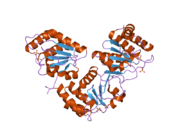Biology:DUSP5
 Generic protein structure example |
Dual specificity protein phosphatase 5 is an enzyme that in humans is encoded by the DUSP5 gene.[1][2]
Function
The protein encoded by this gene is a member of the dual specificity protein phosphatase subfamily. These phosphatases inactivate their target kinases by dephosphorylating both the phosphoserine/threonine and phosphotyrosine residues. They negatively regulate members of the mitogen-activated protein (MAP) kinase superfamily (MAPK/ERK, SAPK/JNK, p38), which are associated with cellular proliferation and differentiation. Different members of the family of dual specificity phosphatases show distinct substrate specificities for various MAP kinases, different tissue distribution and subcellular localization, and different modes of inducibility of their expression by extracellular stimuli. This gene product inactivates ERK1/2, is expressed in a variety of tissues with the highest levels in pancreas and brain, and is localized in the nucleus.[2]
References
- ↑ "Chromosomal localization of four human VH1-like protein-tyrosine phosphatases". Genomics 22 (2): 462–4. Jul 1994. doi:10.1006/geno.1994.1411. PMID 7806236.
- ↑ 2.0 2.1 "Entrez Gene: DUSP5 dual specificity phosphatase 5". https://www.ncbi.nlm.nih.gov/sites/entrez?Db=gene&Cmd=ShowDetailView&TermToSearch=1847.
Further reading
- "Isolation of novel and known genes from a human fetal cochlear cDNA library using subtractive hybridization and differential screening". Genomics 23 (1): 42–50. Sep 1994. doi:10.1006/geno.1994.1457. PMID 7829101.
- "Multiple dual specificity protein tyrosine phosphatases are expressed and regulated differentially in liver cell lines". The Journal of Biological Chemistry 270 (3): 1156–60. Jan 1995. doi:10.1074/jbc.270.3.1156. PMID 7836374.
- "A novel dual specificity phosphatase induced by serum stimulation and heat shock". The Journal of Biological Chemistry 269 (47): 29897–902. Nov 1994. doi:10.1016/S0021-9258(18)43965-8. PMID 7961985.
- "Dual-specificity phosphatase 5 (DUSP5) as a direct transcriptional target of tumor suppressor p53". Oncogene 22 (36): 5586–91. Aug 2003. doi:10.1038/sj.onc.1206845. PMID 12944906.
- "Specific inactivation and nuclear anchoring of extracellular signal-regulated kinase 2 by the inducible dual-specificity protein phosphatase DUSP5". Molecular and Cellular Biology 25 (5): 1830–45. Mar 2005. doi:10.1128/MCB.25.5.1830-1845.2005. PMID 15713638.
- "Crystal structure of the catalytic domain of human DUSP5, a dual specificity MAP kinase protein phosphatase". Proteins 66 (1): 253–8. Jan 2007. doi:10.1002/prot.21224. PMID 17078075.
- "ERK1/2-driven and MKP-mediated inhibition of EGF-induced ERK5 signaling in human proximal tubular cells". Journal of Cellular Physiology 211 (1): 88–100. Apr 2007. doi:10.1002/jcp.20909. PMID 17131384.
External links
- Overview of all the structural information available in the PDB for UniProt: Q16690 (Dual specificity protein phosphatase 5) at the PDBe-KB.
 |


